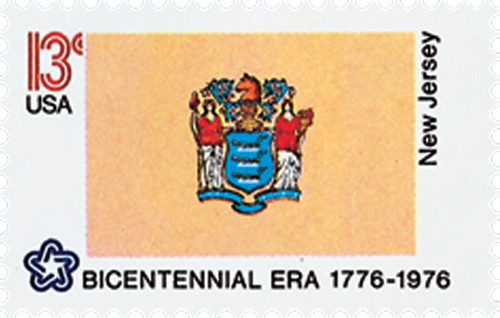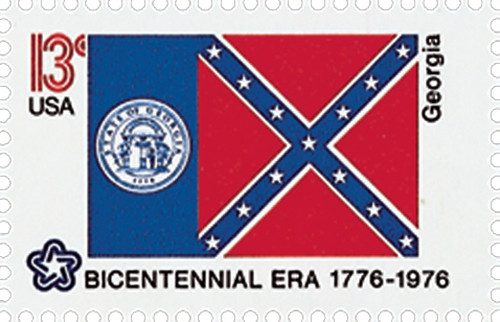
# 1648 - 1976 13c State Flags: Tennessee
U.S. 1648
1976 Tennessee Flag
State Flags
American Bicentennial Series
• First time a sheet 50 had all different stamp designs
• Part of the American Bicentennial Series
Stamp Category: Commemorative
Series: American Bicentennial Series
Value: 13¢ First-class postage rate
First Day of Issue: February 23, 1976
First Day City(s): Washington, DC
Quantity Issued: 8,720,100 (panes of 50)
Printed by: Bureau of Engraving and Printing
Printing Method: Photogravure
Format: Sheet of 50
Perforations: 11
Why the stamp was issued:
The United States Postal Service celebrated the American Bicentennial with a full pane of the Union’s fifty state flags.
About the stamp design:
The three stars on Tennessee’s state flag represent the different land forms in Tennessee – mountains in the east, highlands in the middle and lowlands in the west. These regions are bound together in an unbroken circle on the flag against a crimson field with a blue background for the stars. The final blue strip keeps the flag from showing too much crimson when it is limp.
About the printing process:
Printed by the Bureau of Engraving and Printing on their seven-color Andreotti gravure press (601) which was their work horse for multicolored stamps.
About the American Bicentennial Series:
In the 1970s, America celebrated its 200th anniversary with hundreds of national events commemorating the heroes and historic events that led to our nation’s independence from Great Britain. The U.S. Postal Service issued 113 commemorative stamps over a six-year period in honor of the U.S. bicentennial, beginning with the American Revolution Bicentennial Commission Emblem stamp (U.S. #1432). As a group, the Bicentennial Series chronicles one of our nation’s most important chapters, and remembers the events and patriots who made the U.S. a world model for liberty.
Several of the stamps honored colonial life – craftsmen and communication. Other stamps honored important battles including Lexington and Concord, Bunker Hill, and Saratoga. Significant events such as the Boston Tea Party, the meeting of the First Continental Congress, and the Declaration of Independence were featured as well. The stamps also honored many significant people such as George Washington, Sybil Ludington, Salem Poor, and the Marquis de Lafayette.
Many of the stamps feature classic artwork. For instance, the set of four souvenir sheets picture important events recreated by noted artists such as John Trumbull. The Bicentennial Series also includes an important US postal first – the first 50-stamp se-tenant – featuring all 50 state flags. The format proved to be popular with collectors, and has been repeated many times since.
The American Bicentennial Series is packed with important US history – it tells the story of our nation’s fight for independence through stamps.
History the stamp represents:
On June 1, 1796, Tennessee was admitted to the Union.
The first known groups of Indians to live in Tennessee were the Mound Builders, who moved to the region about 1,000 years ago. They used mounds for burial places, as platforms for temples, and for the homes of chiefs. Many of these mounds are gigantic, and they were built without the aid of horses and oxen. Some of the mounds resemble animals when viewed from high above, and some mounds are shaped geometrically. Cherokee and Chickasaw Indians lived in the region when Europeans arrived.
A party of Spanish explorers led by Hernando de Soto raided some Indian villages in the Tennessee River valley in 1540. The party continued westward, and in 1541, de Soto became the first European to reach the Mississippi River. In 1673, the English explorers James Needham and Gabriel Arthur explored the Tennessee valley, and Louis Jolliet of Canada and Father Jacques Marquette of France sailed down the Mississippi River.
With the conclusion of the French and Indian War, English settlers from Virginia and North Carolina began moving to Tennessee. In fact, the area was governed as part of the colony of North Carolina. However, due to its isolation from the rest of colony – because of the Appalachian, Great Smokey, and Blue Ridge Mountains – it often had little involvement with North Carolina. In 1772, settlers in the area established their own government, the Watauga Association. This government created one of the first written constitutions in North America.
During the American Revolution, pioneers from Tennessee, under the leadership of John Sevier, were a major factor in the victory over the British at the Battle of Kings Mountain, South Carolina, on October 7, 1780.
Conflicts between settlers and Indians increased in Tennessee. In 1784, when North Carolina failed to send aid to the settlers, three counties revolted and formed the State of Franklin. North Carolina regained control of these counties in 1788, but, in 1789, gave ownership of all of Tennessee to the United States. The U.S. named this area The Territory of the United States South of the River Ohio.
On February 6, 1796, the territory adopted a constitution in preparation for statehood. On June 1, 1796, Tennessee became the 16th state to enter the Union. It was the first state to be created out of government territory.
U.S. 1648
1976 Tennessee Flag
State Flags
American Bicentennial Series
• First time a sheet 50 had all different stamp designs
• Part of the American Bicentennial Series
Stamp Category: Commemorative
Series: American Bicentennial Series
Value: 13¢ First-class postage rate
First Day of Issue: February 23, 1976
First Day City(s): Washington, DC
Quantity Issued: 8,720,100 (panes of 50)
Printed by: Bureau of Engraving and Printing
Printing Method: Photogravure
Format: Sheet of 50
Perforations: 11
Why the stamp was issued:
The United States Postal Service celebrated the American Bicentennial with a full pane of the Union’s fifty state flags.
About the stamp design:
The three stars on Tennessee’s state flag represent the different land forms in Tennessee – mountains in the east, highlands in the middle and lowlands in the west. These regions are bound together in an unbroken circle on the flag against a crimson field with a blue background for the stars. The final blue strip keeps the flag from showing too much crimson when it is limp.
About the printing process:
Printed by the Bureau of Engraving and Printing on their seven-color Andreotti gravure press (601) which was their work horse for multicolored stamps.
About the American Bicentennial Series:
In the 1970s, America celebrated its 200th anniversary with hundreds of national events commemorating the heroes and historic events that led to our nation’s independence from Great Britain. The U.S. Postal Service issued 113 commemorative stamps over a six-year period in honor of the U.S. bicentennial, beginning with the American Revolution Bicentennial Commission Emblem stamp (U.S. #1432). As a group, the Bicentennial Series chronicles one of our nation’s most important chapters, and remembers the events and patriots who made the U.S. a world model for liberty.
Several of the stamps honored colonial life – craftsmen and communication. Other stamps honored important battles including Lexington and Concord, Bunker Hill, and Saratoga. Significant events such as the Boston Tea Party, the meeting of the First Continental Congress, and the Declaration of Independence were featured as well. The stamps also honored many significant people such as George Washington, Sybil Ludington, Salem Poor, and the Marquis de Lafayette.
Many of the stamps feature classic artwork. For instance, the set of four souvenir sheets picture important events recreated by noted artists such as John Trumbull. The Bicentennial Series also includes an important US postal first – the first 50-stamp se-tenant – featuring all 50 state flags. The format proved to be popular with collectors, and has been repeated many times since.
The American Bicentennial Series is packed with important US history – it tells the story of our nation’s fight for independence through stamps.
History the stamp represents:
On June 1, 1796, Tennessee was admitted to the Union.
The first known groups of Indians to live in Tennessee were the Mound Builders, who moved to the region about 1,000 years ago. They used mounds for burial places, as platforms for temples, and for the homes of chiefs. Many of these mounds are gigantic, and they were built without the aid of horses and oxen. Some of the mounds resemble animals when viewed from high above, and some mounds are shaped geometrically. Cherokee and Chickasaw Indians lived in the region when Europeans arrived.
A party of Spanish explorers led by Hernando de Soto raided some Indian villages in the Tennessee River valley in 1540. The party continued westward, and in 1541, de Soto became the first European to reach the Mississippi River. In 1673, the English explorers James Needham and Gabriel Arthur explored the Tennessee valley, and Louis Jolliet of Canada and Father Jacques Marquette of France sailed down the Mississippi River.
With the conclusion of the French and Indian War, English settlers from Virginia and North Carolina began moving to Tennessee. In fact, the area was governed as part of the colony of North Carolina. However, due to its isolation from the rest of colony – because of the Appalachian, Great Smokey, and Blue Ridge Mountains – it often had little involvement with North Carolina. In 1772, settlers in the area established their own government, the Watauga Association. This government created one of the first written constitutions in North America.
During the American Revolution, pioneers from Tennessee, under the leadership of John Sevier, were a major factor in the victory over the British at the Battle of Kings Mountain, South Carolina, on October 7, 1780.
Conflicts between settlers and Indians increased in Tennessee. In 1784, when North Carolina failed to send aid to the settlers, three counties revolted and formed the State of Franklin. North Carolina regained control of these counties in 1788, but, in 1789, gave ownership of all of Tennessee to the United States. The U.S. named this area The Territory of the United States South of the River Ohio.
On February 6, 1796, the territory adopted a constitution in preparation for statehood. On June 1, 1796, Tennessee became the 16th state to enter the Union. It was the first state to be created out of government territory.

















